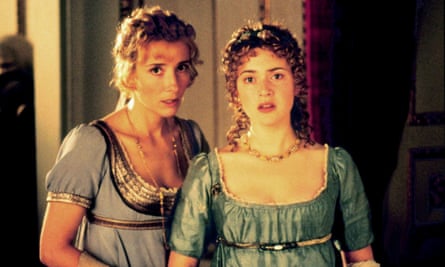This year marks what would have been Jane Austen’s 250th birthday, and getting stuck into the great Regency writer’s brilliant work is the best way to celebrate. Perhaps you’ve seen the film adaptations, or dipped into Pride and Prejudice, but what about the more obscure Lady Susan? Writer and professor John Mullan has come up with a handy guide to Austen’s writing.
The entry point
Pride and Prejudice. What else could it be? It bursts on the first-time reader now, as it must have burst on the first readers in the winter of 1813. It’s the best attraction-disguised-as-antagonism love story ever, with the most irreverent of heroines, the “arch” Elizabeth Bennett, and an hilarious supporting cast (Mr Collins! Lady Catherine de Bourgh!). We love the fencing between Elizabeth and Mr Darcy, but all the dialogue is scintillating. Just read that first chapter: a couple of pages of conversation between Mr and Mrs Bennet (we never find out their first names) give you the very anatomy of a marriage.
The one to make you cry
Persuasion is the one for romantics, and for readers who have lived long enough to know their own mistaken choices. Anne Elliot is subtle and perceptive, soulful and affectionate. Aged 19, she was in love with a dashing but impecunious naval officer, Frederick Wentworth, but she was persuaded to turn down his offer of marriage. Now she is 27 and she is melancholy and regretful. Then Wentworth comes back into her life, offering a second chance of happiness.
The one to drop into dinner party conversation
When she died, aged only 41, Jane Austen was working on a new book. She left us with eleven-and-a-bit chapters of a novel to be called Sanditon (not to be confused in any way with the three-series ITV drama of the same name). The title is taken from the new-build seaside resort where the typically astute and humorous heroine, Charlotte Heywood, goes to stay. It is peopled by property speculators, hypochondriacs, and an aristocratic would-be seducer. You can patiently explain to your friends that it would have been a cracker, if only its author had lived.
The one that might surprise you
This is a novel about two teenage sisters, sensible Elinor (19) and impulsive Marianne (17). Austen recruits your sympathy with Marianne – she scorns pretension and falsehood, she plays moody piano, she dances into the small hours – only to let you see where you erred. On reflection, Marianne says and does many foolish things. She talks to trees; she thinks that a woman in her late 20s “can never hope to feel or inspire affection again”; she throws herself at a mercenary rake; she never understands irony. Elinor, on the other hand, seems in control, but actually seethes with passion and sadness, and has a sense of humour. It is really her story.

The one for aficionados
When Austen’s letters began to be published in the late 19th century, many readers were disappointed. Mostly written to her sister Cassandra (who burned what we imagine were the novelist’s more interesting missives), they report the weather, the latest family illnesses, and gossip about Hampshire neighbours. However, once you really know your Austen, aided by Deirdre Le Faye’s brilliant biographical index to the best edition of these letters, you can find all sorts of amusement and slyness. And the odd killer aphorism: “Pictures of perfection make me sick & wicked.”
after newsletter promotion
The one to go back to
If you think that Fanny Price, the heroine of this one, is a prim goody-two-shoes, and the book a big letdown after sparkling Pride and Prejudice – think again! In some ways Austen’s deepest novel, Mansfield Park is an exploration of a put-upon, neglected, highly intelligent young woman with a Brontë-level secret passion (for her unperceptive cousin, Edmund). Fanny must stay true to herself, while observing the idiocies of the entitled Bertrams, who have adopted her, and circumventing the schemes of the charming but diabolical Mary Crawford. A true heroine.
The one to make you laugh out loud
When Austen was 19 or 20, she wrote this novella in letters, whose main correspondent is the beautiful, amoral Lady Susan Vernon, a knowingly sexy widow in her mid-30s, she likes to conquer men, though she is too clever actually to sleep with them. When she is not casting her spell on one beau or another, she is scheming to marry off her irritatingly virtuous daughter. Lady Susan’s wittily cynical letters to her confidante Mrs Johnson (Alicia) are a devilish hoot.
The one that will make you feel like a teenager again
You don’t really need to have read any foolish gothic fiction to get Northanger Abbey, though Austen’s satire of absurd novels and their readers is delicious. You just need to have been young, which is the main point of this story of a naive yet perceptive 17-year-old country vicar’s daughter, Catherine Morland. Invited to Bath by a family friend, she loves society’s whirl – and discovers love. The sheer delicious giddiness of young life (including falling for the falsest of false friends, Isabella Thorpe) has never been better done.
The masterpiece
Emma, Austen’s longest and most elaborately plotted novel is as revolutionary as Madame Bovary or Ulysses. It is narrated almost entirely from the point of view of its heroine, Emma Woodhouse, who is wrong about almost everything. The reader has to share her mistakes and delusions, with no direction from the author to put them right. “Handsome, clever and rich,” Emma, a self-appointed match-maker, meddles disastrously in others’ lives, convinced that she knows what they are thinking. This is high-wire comedy, on the brink of disaster, with Mrs Elton (O, gloriously vulgar, utterly self-admiring Mrs Elton!) as Emma’s distorted semblable, and only Mr Knightley to bring out her true qualities. It is that cleverest of love stories, where the heroine does not recognise that she is in love until it is (almost) too late. “I am going to take a heroine whom no one but myself will much like,” declared the novelist, in mischief. She knew this was not true.

 3 months ago
66
3 months ago
66

















































